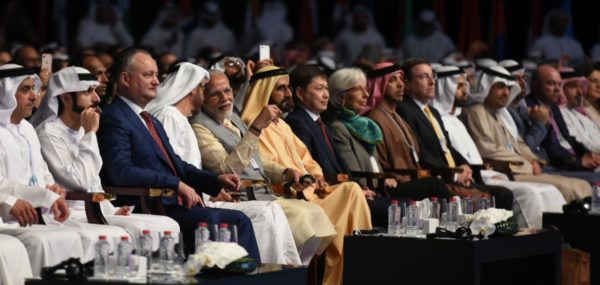Prime Minister Narendra Modi’s visit to the United Arab Emirates over the weekend, as part of his four-day tour to the Middle East, generated much excitement in the Indian media. On Saturday, Prime Minister Modi and Crown Prince of Abu Dhabi Mohamed bin Zayed Al Nahyan held detailed discussions on a wide array of issues, ranging from trade, energy, climate change and civil aviation.
In the joint statement issued at the end of Modi’s visit to the UAE, it was noted that bilateral trade between the two nations stood at $53 billion in 2016-17 making the UAE, India’s third largest trading partner. The UAE is also India’s second largest destination for its exports. Early last year when the Crown Prince arrived in India as New Delhi’s guest of honour for its 68th Republic Day celebrations, both nations had decided to increase trade by 60% over the next five years.
“They acknowledged the positive effect presence of a number of Indian and UAE companies in each other’s market has in bilateral trade promotion efforts,” the joint statement said.
UAE’s significance to India also stems from the fact that it is home to 2.6 million working Indians, making them the largest immigrant community. Reports indicate that Indian migrant workers sent back 14.64 billion Emirati dirhams during the second quarter of 2017-18, which translates to more than
Rs 25 billion.
According to the UAE Central Bank, this amounts to nearly 35.9% of the total value of remittances sent by immigrant workers during the second quarter of 2017-18. The UAE is India’s biggest source of remittances from nations within the Gulf Cooperation Council (GCC), accounting for 38.7%.
Most of the migrant population comes from the southern states of Kerala, Andhra Pradesh, Tamil Nadu, Karnataka and Telangana. Others come from Uttar Pradesh, Bihar, Goa and Maharashtra. They work in various capacities, as nurses in hospitals, construction workers and contractors aiding the spurt of real estate development.
Working conditions for Indian migrants, however, aren’t very good, an issue the prime minister has promised to address. Changing policies against foreign migrants with job quotas for the local populace, rampant exploitation and unsafe working conditions remain serious issues that the Government of India must resolve soon with its counterparts.
Although the government had launched online portals for distressed Indian workers, there were reports of glitches. Moreover, many of these workers are semi-literate or illiterate, and thus have little to gain from this portal. Other concerns include massive fraud on the part of middlemen who defraud unskilled workers under the pretext of offering lucrative jobs but land up in a UAE prison for illegal travel documents on arrival.
India also depends on the UAE for its vast reserves of oil. A significant breakthrough during Prime Minister Modi’s visit was the MoU signed between a consortium of public sector Indian companies and the Abu Dhabi National Oil Co (ADNOC), allowing the former a 10% participating interest in a major offshore field, reported the Press Trust of India.
During the Crown Prince’s last visit, both sides signed a strategic oil reserve deal pact that allows the UAE “to fill half of an underground crude oil storage facility at Mangalore that is part of New Delhi’s strategic reserve [emergency] system,” according to Reuters.
On Saturday, ADNOC took this deal a step further with the Indian Strategic Petroleum Reserves Ltd. This underground storage facility in Mangalore is part of India’s endeavour to hedge against volatility in the global oil market, since the country imports more than 80% of its oil. Both sides have also sought greater cooperation in renewable energy while working together to fulfil climate change commitments.
Finally, both sides also made significant strides in dealing with the scourge of terrorism and radicalisation. The joint statement at the end of Prime Minister Modi’s visit spoke of how Indian institutions can work with “UAE-based Sawab and Hedayah centres to countering extremist ideologies” at schools and religious centres.
They also agreed to conduct a bilateral naval exercise, allowing the Indian Navy for the first time to operate off the shores of Abu Dhabi. “It shows recognition that we have a shared interest in maritime security against piracy, in keeping the sea lanes open, in ensuring the freedom of navigation and perhaps also the recognition of what our forefathers knew: that our countries are neighbours separated only by water,” said Navdeep Suri, India’s Ambassador to the UAE.
In matters of defence and strategic affairs, there is seemingly a good deal of convergence. Last year, the joint statement made references to tackling radical outfits like ISIS and development of Afghanistan. What took some analysts by surprise was the veiled support for India on the issue of Kashmir.
One area for improvement is the inability of both sides to facilitate greater investment in projects in India. There was little movement on the $75 billion UAE-India infrastructure investment fund established during Prime Minister last visit to the Gulf nation in 2015. India can tap into the vast reserves of foreign exchange the UAE possesses to propel industrial growth and facilitate infrastructure building.






Leave a reply